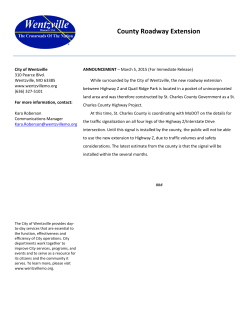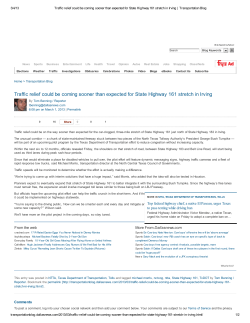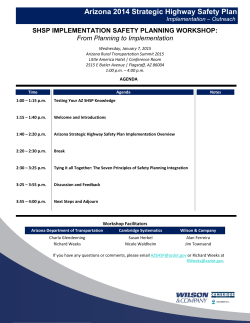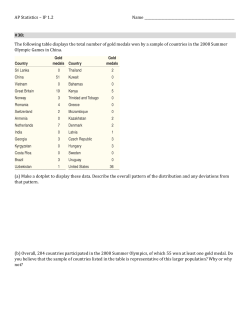
CIVIL BREADTH and TRANSPORTATION DEPTH Exam
NCEES Principles and Practice of Engineering Examination CIVIL BREADTH and TRANSPORTATION DEPTH Exam Specifications Effective Beginning with the April 2015 Examinations • The civil exam is a breadth and depth examination. This means that examinees work the breadth (AM) exam and one of the five depth (PM) exams. • The five areas covered in the civil examination are construction, geotechnical, structural, transportation, and water resources and environmental. The breadth exam contains questions from all five areas of civil engineering. The depth exams focus more closely on a single area of practice in civil engineering. • Examinees work all questions in the morning session and all questions in the afternoon module they have chosen. Depth results are combined with breadth results for final score. • The exam is an 8-hour open-book exam. It contains 40 multiple-choice questions in the 4-hour AM session, and 40 multiple-choice questions in the 4-hour PM session. • The exam uses both the International System of Units (SI) and the US Customary System (USCS). • The exam is developed with questions that will require a variety of approaches and methodologies, including design, analysis, and application. Some problems may require knowledge of engineering economics. • The knowledge areas specified as examples of kinds of knowledge are not exclusive or exhaustive categories. • The specifications for the AM exam and the Transportation PM exam are included here. The design standards applicable to the Transportation PM exam are shown on the last page. CIVIL BREADTH Exam Specifications Approximate Number of Questions I. Project Planning A. Quantity take-off methods B. Cost estimating C. Project schedules D. Activity identification and sequencing 4 II. Means and Methods A. Construction loads B. Construction methods C. Temporary structures and facilities 3 III. Soil Mechanics A. Lateral earth pressure B. Soil consolidation C. Effective and total stresses D. Bearing capacity E. Foundation settlement F. Slope stability 6 1 Civil Breadth Exam Specifications Continued IV. Structural Mechanics A. Dead and live loads B. Trusses C. Bending (e.g., moments and stresses) D. Shear (e.g., forces and stresses) E. Axial (e.g., forces and stresses) F. Combined stresses G. Deflection H. Beams I. Columns J. Slabs K. Footings L. Retaining walls 6 V. Hydraulics and Hydrology A. Open-channel flow B. Stormwater collection and drainage (e.g., culvert, stormwater inlets, gutter flow, street flow, storm sewer pipes) C. Storm characteristics (e.g., storm frequency, rainfall measurement and distribution) D. Runoff analysis (e.g., Rational and SCS/NRCS methods, hydrographic application, runoff time of concentration) E. Detention/retention ponds F. Pressure conduit (e.g., single pipe, force mains, Hazen-Williams, Darcy-Weisbach, major and minor losses) G. Energy and/or continuity equation (e.g., Bernoulli) 7 VI. Geometrics A. Basic circular curve elements (e.g., middle ordinate, length, chord, radius) B. Basic vertical curve elements C. Traffic volume (e.g., vehicle mix, flow, and speed) 3 VII. Materials A. Soil classification and boring log interpretation B. Soil properties (e.g., strength, permeability, compressibility, phase relationships) C. Concrete (e.g., nonreinforced, reinforced) D. Structural steel E. Material test methods and specification conformance F. Compaction 6 VIII. Site Development A. Excavation and embankment (e.g., cut and fill) B. Construction site layout and control C. Temporary and permanent soil erosion and sediment control (e.g., construction erosion control and permits, sediment transport, channel/outlet protection) D. Impact of construction on adjacent facilities E. Safety (e.g., construction, roadside, work zone) 5 2 CIVIL–TRANSPORTATION Depth Exam Specifications Approximate Number of Questions I. Traffic Engineering (Capacity Analysis and Transportation Planning) A. Uninterrupted flow (e.g., level of service, capacity) B. Street segment interrupted flow (e.g., level of service, running time, travel speed) C. Intersection capacity (e.g., at grade, signalized, roundabout, interchange) D. Traffic analysis (e.g., volume studies, peak hour factor, speed studies, modal split) E. Trip generation and traffic impact studies F. Accident analysis (e.g., conflict analysis, accident rates, collision diagrams) G. Nonmotorized facilities (e.g., pedestrian, bicycle) H. Traffic forecast I. Highway safety analysis (e.g., crash modification factors, Highway Safety Manual) II. Horizontal Design A. Basic curve elements (e.g., middle ordinate, length, chord, radius) B. Sight distance considerations C. Superelevation (e.g., rate, transitions, method, components) D. Special horizontal curves (e.g., compound/reverse curves, curve widening, coordination with vertical geometry) 4 III. Vertical Design A. Vertical curve geometry B. Stopping and passing sight distance (e.g., crest curve, sag curve) C. Vertical clearance 4 IV. Intersection Geometry A. Intersection sight distance B. Interchanges (e.g., freeway merge, entrance and exit design, horizontal design, vertical design) C. At-grade intersection layout, including roundabouts 4 V. Roadside and Cross-Section Design A. Forgiving roadside concepts (e.g., clear zone, recoverable slopes, roadside obstacles) B. Barrier design (e.g., barrier types, end treatments, crash cushions) C. Cross-section elements (e.g., lane widths, shoulders, bike lane, sidewalks) D. Americans with Disabilities Act (ADA) design considerations 4 VI. Signal Design A. Signal timing (e.g., clearance intervals, phasing, pedestrian crossing timing, railroad preemption) B. Signal warrants 3 VII. Traffic Control Design A. Signs and pavement markings B. Temporary traffic control 3 3 11 Civil–Transportation Depth Exam Specifications Continued VIII. Geotechnical and Pavement A. Design traffic analysis (e.g., equivalent single-axle load [ESAL]) B. Sampling and testing (e.g., subgrade resilient modulus, CBR, R-Values, field tests) C. Mechanistic design procedures (e.g., flexible and rigid pavement) D. Pavement evaluation and maintenance measures (e.g., skid, roughness, structural capacity, rehabilitation treatments) E. Settlement and compaction F. Soil stabilization techniques G. Excavation, embankment, and mass balance 4 IX. Drainage A. Hydrology (e.g., Rational method, hydrographs, SCS/NRCS method) B. Culvert design, including hydraulic energy dissipation C. Stormwater collection systems (e.g., inlet capacities, pipe flow) D. Gutter flow E. Open-channel flow F. Runoff detention/retention/water quality mitigation measures 2 X. Alternatives Analysis A. Economic analysis (e.g., present worth, lifecycle costs) 1 4 NCEES Principles and Practice of Engineering Examination TRANSPORTATION Design Standards Effective Beginning with the April 2015 Examinations ABBREVIATION DESIGN STANDARD TITLE AASHTO A Policy on Geometric Design of Highways and Streets, 6th edition, 2011, American Association of State Highway & Transportation Officials, Washington, DC. AASHTO Guide for Design of Pavement Structures (GDPS-4-M), 1993, and 1998 supplement, American Association of State Highway & Transportation Officials, Washington, DC. AASHTO Roadside Design Guide, 4th edition, 2011, American Association of State Highway & Transportation Officials, Washington, DC. AASHTO Mechanistic-Empirical Pavement Design Guide: A Manual of Practice, interim edition, July 2008, American Association of State Highway & Transportation Officials, Washington, DC. AASHTO Guide for the Planning, Design, and Operation of Pedestrian Facilities, 1st edition, 2004, American Association of State Highway & Transportation Officials, Washington, DC. AASHTO Highway Safety Manual, 1st ed., vol. 1, 2010, American Association of State Highway & Transportation Officials, Washington, DC. AI HCM MUTCD The Asphalt Handbook (MS-4), 7th edition, 2007, Asphalt Institute, Lexington, KY. Highway Capacity Manual 2010, Transportation Research Board—National Research Council, Washington, DC. Manual on Uniform Traffic Control Devices, 2009, including Revisions 1 and 2 dated May 2012, U.S. Department of Transportation—Federal Highway Administration, Washington, DC. PCA Design and Control of Concrete Mixtures, 15th edition, 2011, Portland Cement Association, Skokie, IL. FHWA Hydraulic Design of Highway Culverts, Hydraulic Design Series Number 5, Publication No. FHWA-HIF-12-026, 3rd edition, April 2012, U.S. Department of Transportation—Federal Highway Administration, Washington, DC. 5
© Copyright 2025





















